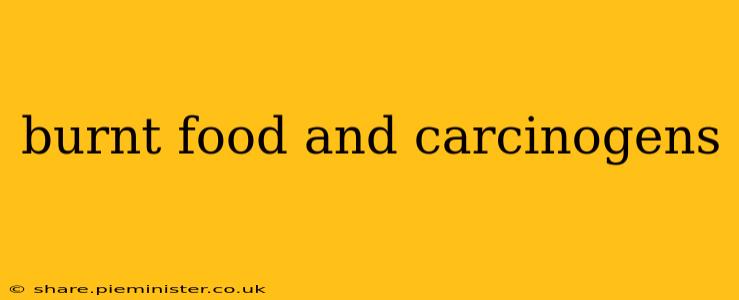Burnt food, that unfortunately familiar sight and smell, often evokes a sigh of disappointment. But beyond the unpleasant taste and texture, a more serious concern arises: the potential formation of harmful carcinogens. This article delves into the science behind burnt food and its link to cancer, addressing common questions and offering practical advice to minimize your exposure.
What are Carcinogens?
Carcinogens are substances that can cause cancer. They damage DNA, potentially leading to uncontrolled cell growth and the development of tumors. Many carcinogens are naturally occurring, while others are created through human activities, such as industrial processes and, relevant to our topic, the cooking process.
How Does Burning Food Create Carcinogens?
The high temperatures involved in burning food trigger chemical reactions that produce heterocyclic amines (HCAs) and polycyclic aromatic hydrocarbons (PAHs). These compounds are known carcinogens.
- HCAs: These form when amino acids (building blocks of protein) react with creatine (found in muscle meat) at high temperatures. Red and processed meats are particularly susceptible to HCA formation when cooked at high temperatures.
- PAHs: These are produced when fat and meat juices drip onto the heat source (like a grill or pan) and create smoke. This smoke then comes into contact with the food, transferring PAHs. Grilling, barbecuing, and broiling are common cooking methods that generate PAHs.
Does All Burnt Food Contain Carcinogens?
While burning food significantly increases the risk of carcinogen formation, it’s important to note that not all slightly browned or charred food contains dangerous levels of these compounds. The level of carcinogens produced depends on several factors, including:
- Cooking Method: Grilling, broiling, and frying at high temperatures are more likely to produce carcinogens than boiling or steaming.
- Cooking Time: Prolonged cooking at high temperatures leads to greater carcinogen formation.
- Type of Food: Meats, especially red and processed meats, tend to generate higher levels of HCAs than other food types.
- Degree of Burning: The more severely burnt the food, the higher the concentration of carcinogens.
Are Carcinogens in Burnt Food the Only Cause of Cancer?
No. Cancer is a complex disease with multiple contributing factors. While exposure to carcinogens from burnt food increases cancer risk, it's rarely the sole cause. Other factors like genetics, lifestyle choices (smoking, alcohol consumption, lack of physical activity), and exposure to other carcinogens play significant roles.
How Can I Reduce My Exposure to Carcinogens in Burnt Food?
Several strategies can help minimize your intake of carcinogens from burnt food:
- Trim visible fat: Before cooking, trim away excess fat from meats to reduce dripping and PAH formation.
- Avoid charring: Cook food at lower temperatures for longer periods, avoiding excessive browning or burning.
- Marinate meats: Marinades can help reduce HCA formation.
- Don't reuse cooking oil: Repeatedly heating oil increases the risk of carcinogen formation.
- Use a meat thermometer: Cook meats to their recommended internal temperature to ensure they are fully cooked without overcooking.
- Choose healthier cooking methods: Boiling, steaming, poaching, and baking are generally safer options.
What are the Health Risks Associated with Eating Burnt Food Regularly?
Regular consumption of burnt food increases the risk of several types of cancer, including colorectal, stomach, pancreatic, and prostate cancers. The exact level of risk depends on the frequency and amount of burnt food consumed, as well as other contributing factors to cancer risk.
Is it Safe to Eat Slightly Browned Food?
Slightly browned food is generally considered safe. The concern arises with severely charred or blackened food where significantly higher levels of carcinogens are produced.
How can I tell if my food is burnt?
Burnt food often has a dark brown or black color, a bitter taste, and a smoky smell. If you notice these characteristics, it's best to discard the food.
By understanding the link between burnt food and carcinogens and adopting these simple precautions, you can significantly reduce your risk and maintain a healthier diet. Remember, moderation and a balanced approach to cooking are key to minimizing the potential risks associated with burnt food.
